HOW TO BE A MOTORCYCLE TEST RIDER
Click on images to enlarge
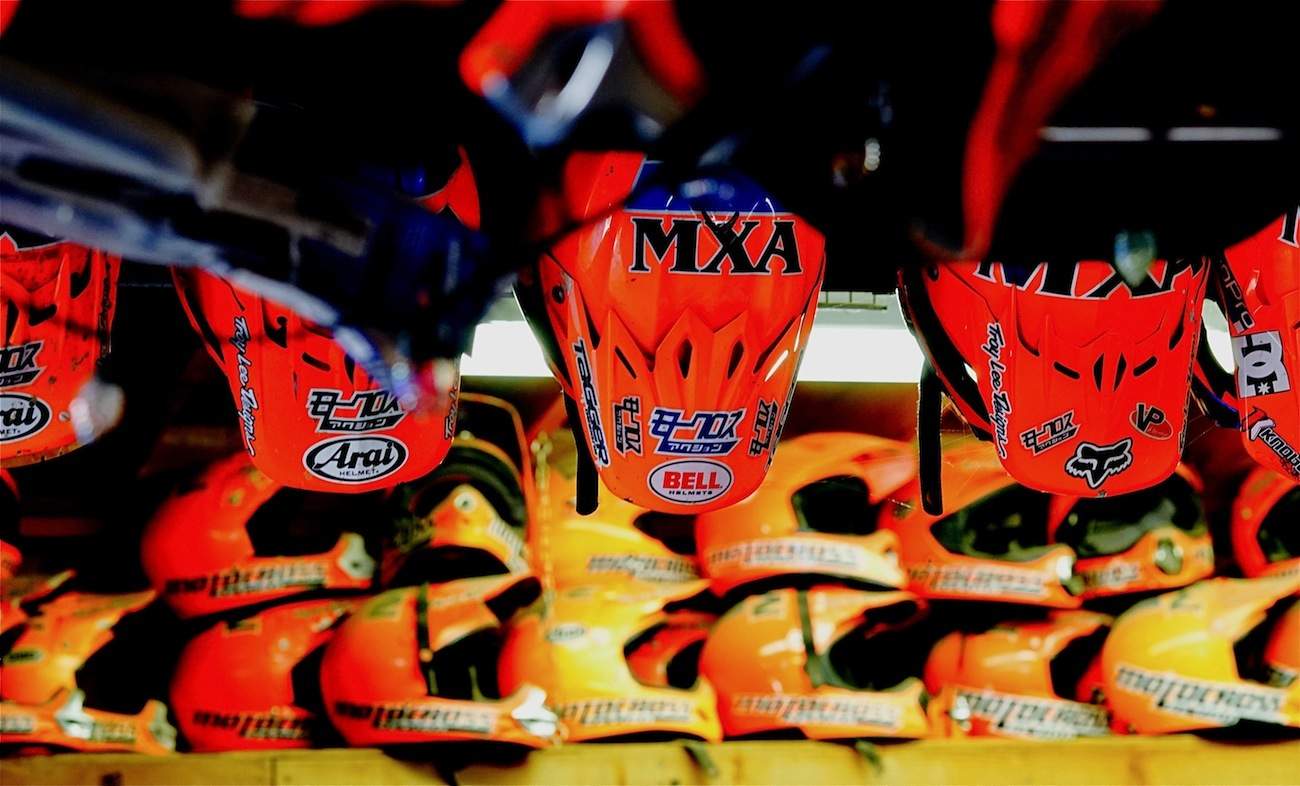 How many helmets have you gone through in your career? These are the tools of the trade for an MXA test rider.
How many helmets have you gone through in your career? These are the tools of the trade for an MXA test rider.
By Jody Weisel
I don’t suppose that there is anything especially unique about me that would lead to my Darwinian selection as a motorcycle test rider, except for one thing! By an accident of birth and serendipitous timing, I was born into a glorious age of excess, rebellion and, most of all, the formative birth of risk sports. Thanks to genes and modern medical advances, I have managed to live in the limelight longer than my test rider brethren from the same era.
You’ve probably heard the term “baby boom” before, but never knew where the phrase came from. Over 70 years ago, American sweethearts put their lives on hold for four long years (from 1941 to 1945) to rid the world of evil. The gals, barely out of bobby sox, kept the home fires burning, while their guys slogged their way across thousands of filthy little battlefields without names. As for my father, he flew a Boeing B-17 out of Ridgewell, England, to bomb ball bearing factories, ship yards and munitions dumps in Germany. Once the WWII concluded, eight million fighting men came flooding back to the heartland…home to their personal Rosie the Riveters.
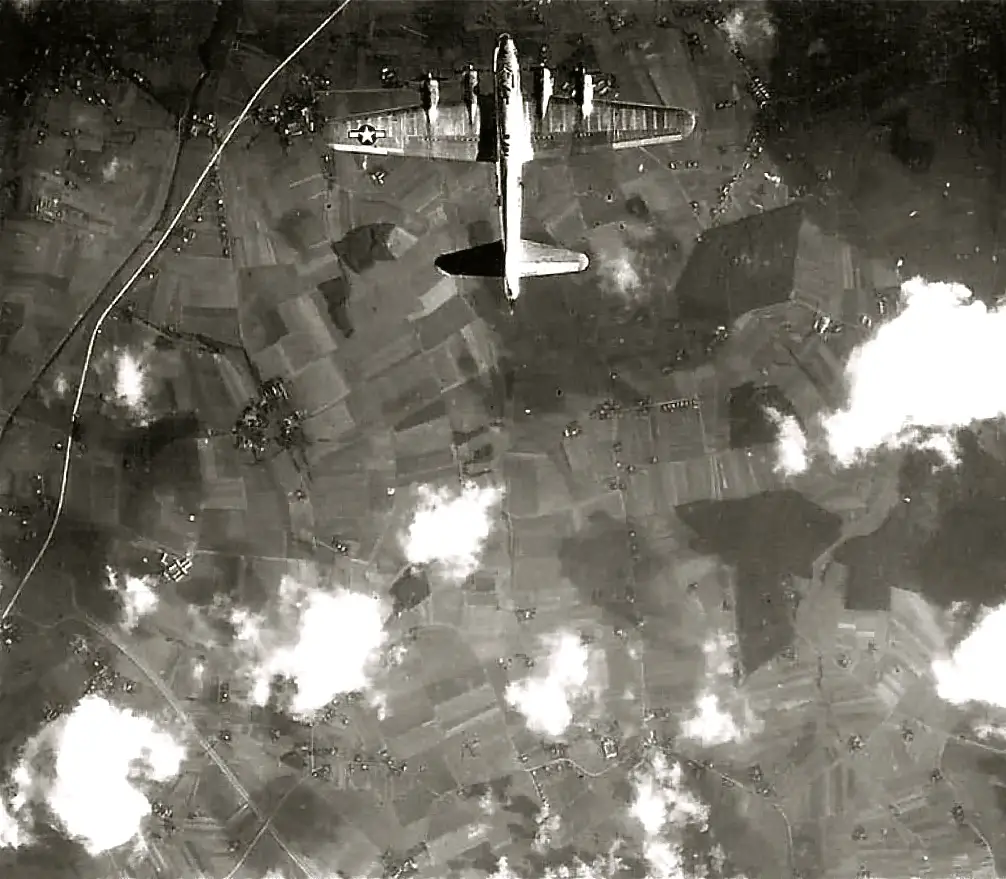 The first motocross boom was fueled by the children of the men who fought in World War II. Jody’s father flew 25 mission over Germany in a B-17.
The first motocross boom was fueled by the children of the men who fought in World War II. Jody’s father flew 25 mission over Germany in a B-17.
Nine months later, the “Baby Boom” started. During the first 12 months after the war, kids were popping out at the rate of 338,000 a month, and doctors delivered 3.4 million children in 1946. By 1947 that number had increased by one million babies more. And, from 1954 on, four million little boomers appeared in swaddling cloth each year—peaking at 4.3 million in 1957. At my house, my brother came first, born exactly nine months to the day from when my B-17 pilot dad came home after VJ day.
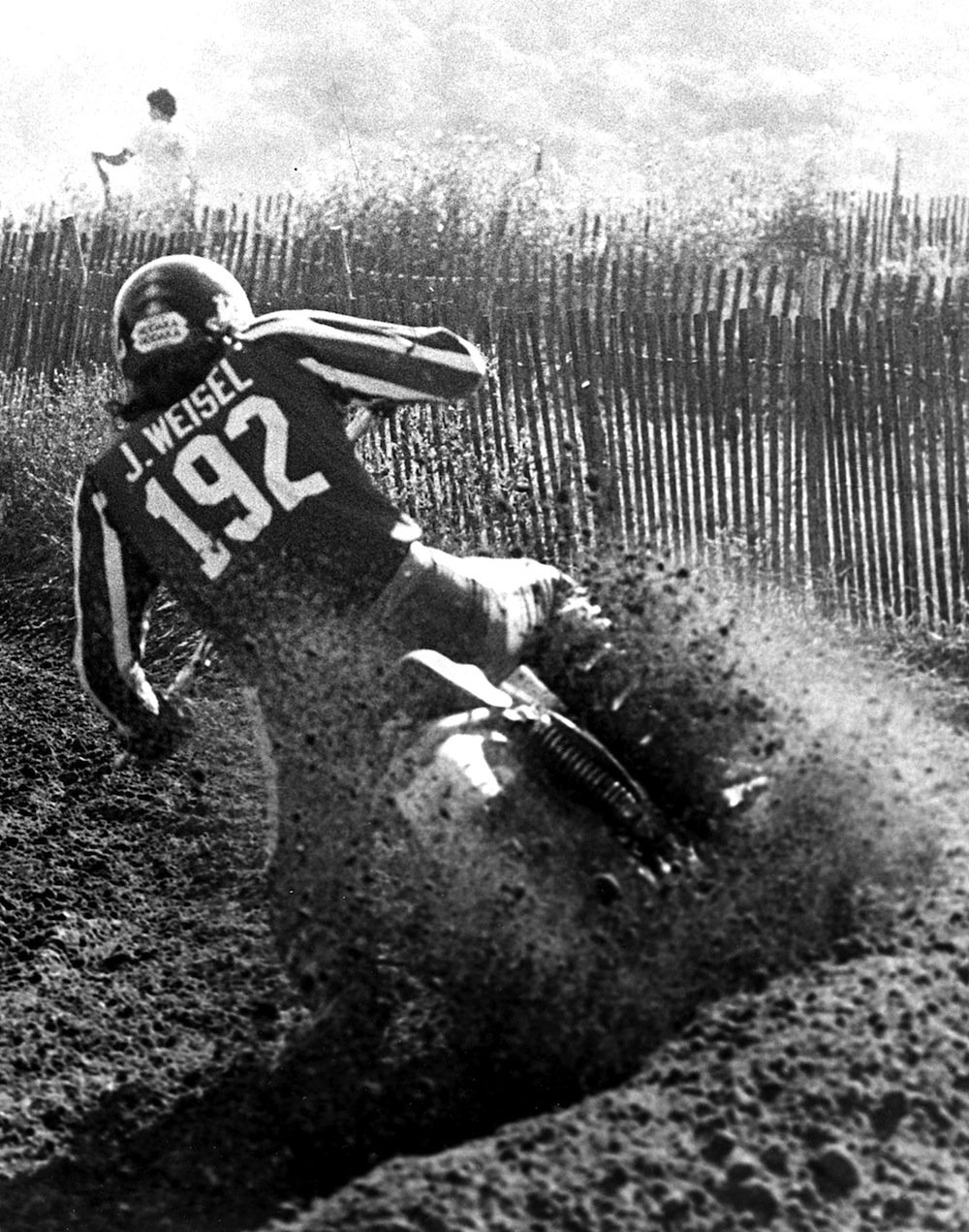 There was nothing cooler in 1974 than riding a Maico. It was the ultimate in German worksmanship, and status came with Maico ownership. Jody hammers a Lake Whitney berm.
There was nothing cooler in 1974 than riding a Maico. It was the ultimate in German worksmanship, and status came with Maico ownership. Jody hammers a Lake Whitney berm.
You might think that I would be a little jealous of my brother, having to wait to make my debut at Letterman General Hospital, just below the Golden Gate Bridge, 19 months later. Not so. That year-and-a-half of waiting made all the difference in the world. In all candor, had I been born first, there would have been little chance of me becoming a motocross racer. My older, and only, brother, missed the cusp of what was to be the brave new world of the “Sixties.” Although less than two years older than me, he grew up as a hot rodder. He was a juvenile delinquent with a ducktail hairdo (what we younger kids called a JD with a DA). He loved all things Elvis, wore black leather jackets, and thought that the twang of Duane Eddy was the sound of the future. But his Blackboard Jungle generation was not mine. I came to adolescence with the Beatles, hippies, microbuses, long hair, Weathermen, Kent State, Selma, Da Nang, Yasgur’s farm, 13th Floor Elevators, surfing and motocross.
MOTOCROSS IN THE LATE ’60s WAS NOTHING LIKE IT IS TODAY. THERE WEREN’T ANY JAPANESE MOTOCROSS BIKES. TWO-STROKES WERE IN THEIR INFANCY. ONLY GROWN MEN RACED MOTORCYCLES.
 To honor his father’s service, Jody’s Varga VG-21 carries the “Triangle L” insignia that was on his father’s B-17 back in 1944.
To honor his father’s service, Jody’s Varga VG-21 carries the “Triangle L” insignia that was on his father’s B-17 back in 1944.
Motocross in the late ’60s was nothing like it is today. It wasn’t mainstream. There wasn’t a race track in every town. There weren’t any Japanese motocross bikes. The minicycle hadn’t been invented (thus, minicycle fathers had yet to plague the planet). Two-strokes were in their infancy. We wore leather pants and open face helmets. Only grown men raced motorcycles, kids didn’t (and if a kid tried, he grew up fast).
I didn’t know, back in the Sixties, that that there was any such job description as a motorcycle test rider. But what I do know now is that thanks to the baby boom, American motocross was made possible. From the moment the first post-World War II baby was born, a clock started ticking on American society. Social theorists of the time knew that something big was going to happen in the streets of America as soon as the 30,000,000 children of the Greatest Generation became teenagers. Pampered and protected by parents who had lived hard lives through the Great Depression, WWII and the Korea Conflict, the Dr. Spock babies burst into the Sixties ready to change the world, flood the schools and change the status quo.
Teenagers in the Sixties went looking for thrills. Bred on stick-and-ball sports, they rebelled by seeking out a new genre of sport — one that had never been popular with kids before — the risk sport.
I WAS IN THE MOMENT; IN THE RIGHT SPOT AT THE RIGHT TIME; RISK SPORTS NEED YOUNG PEOPLE TO THRIVE. THE BABY BOOM WAS A BONANZA FOR MOTORCYCLE SALES.
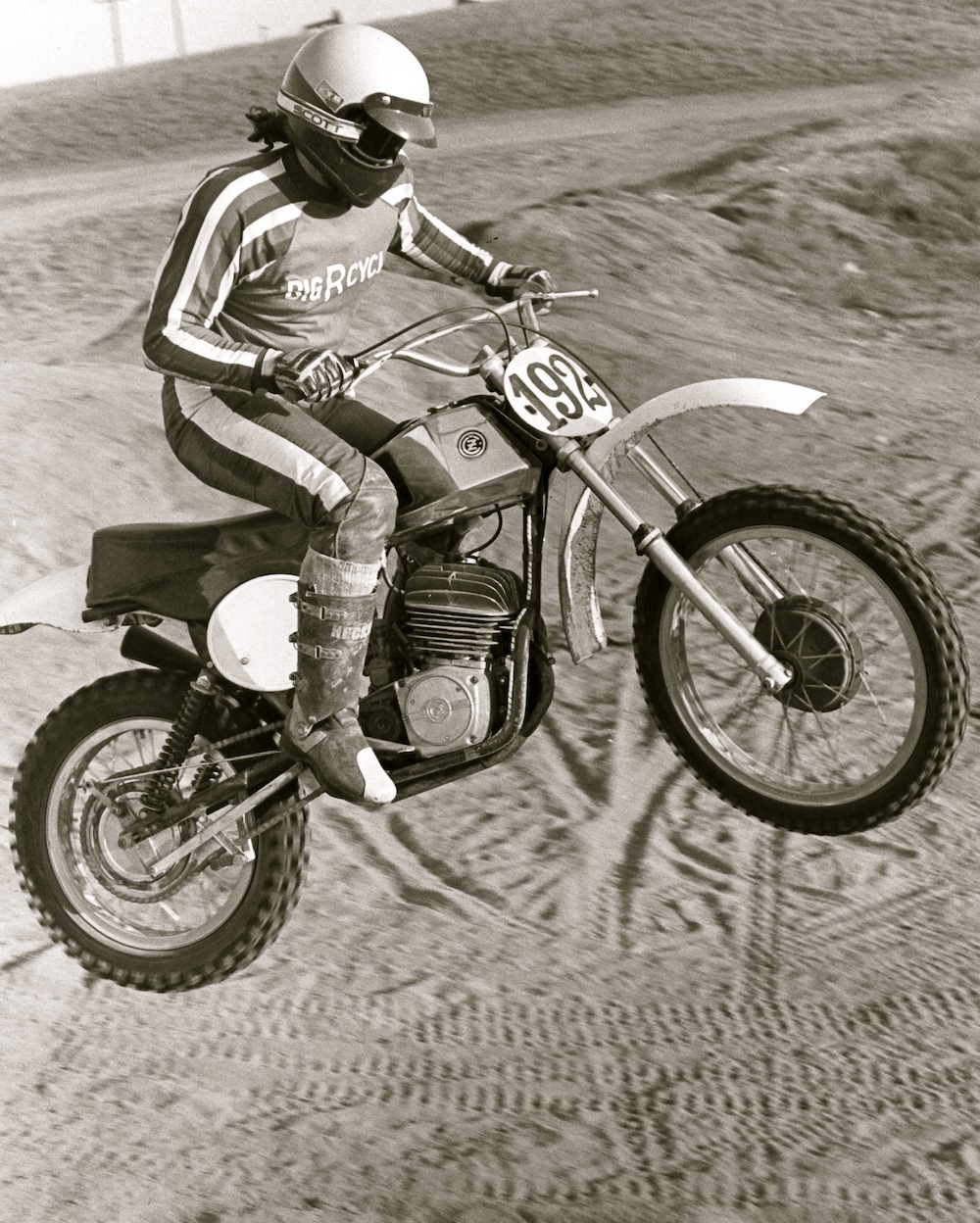 By mid Seventies the motocross world was in transition. It was the end of the line for Old World bikes like CZ, even one with a center-port kit. Jody’s leather pants, Heckel boots and socks over the boots were out of place with his new generation Bell Moto-Star helmet.
By mid Seventies the motocross world was in transition. It was the end of the line for Old World bikes like CZ, even one with a center-port kit. Jody’s leather pants, Heckel boots and socks over the boots were out of place with his new generation Bell Moto-Star helmet.
Although risk sports weren’t invented by the Flower Power Generation, what was new was the fervor with which young people sought out adventure. Prior to the Sixties, risk sports were reserved for adults: Maury Rose was 41 when he won the Indy 500 in 1947, Sir Edmund Hillary was 33 when he scaled Mt. Everest in 1953, and Ernest Hemmingway was 34 when he wrote his 1932 bullfighting manifesto “Death in the Afternoon.” And that about covered the gamut of risk sports before the Sixties…race car driving, mountain climbing and bullfighting.
For comparison, I was 16 when I first paddled out to ride the giants at Lunada Bay (at the time the only ridable big wave on the West Coast). I was only a little older when my dad bought me a Puch dirt bike, and not much more than 18 years old when I took the controls of an airplane for the first time. I wasn’t unusual — just a small part of a big movement that has led to a wholesale change in the way sports are looked at and played. I was in the moment; in the right spot at the right time; lucky to be part of the baby boom. Risk sports need young people to thrive. The baby boom was a bonanza for motorcycle sales.
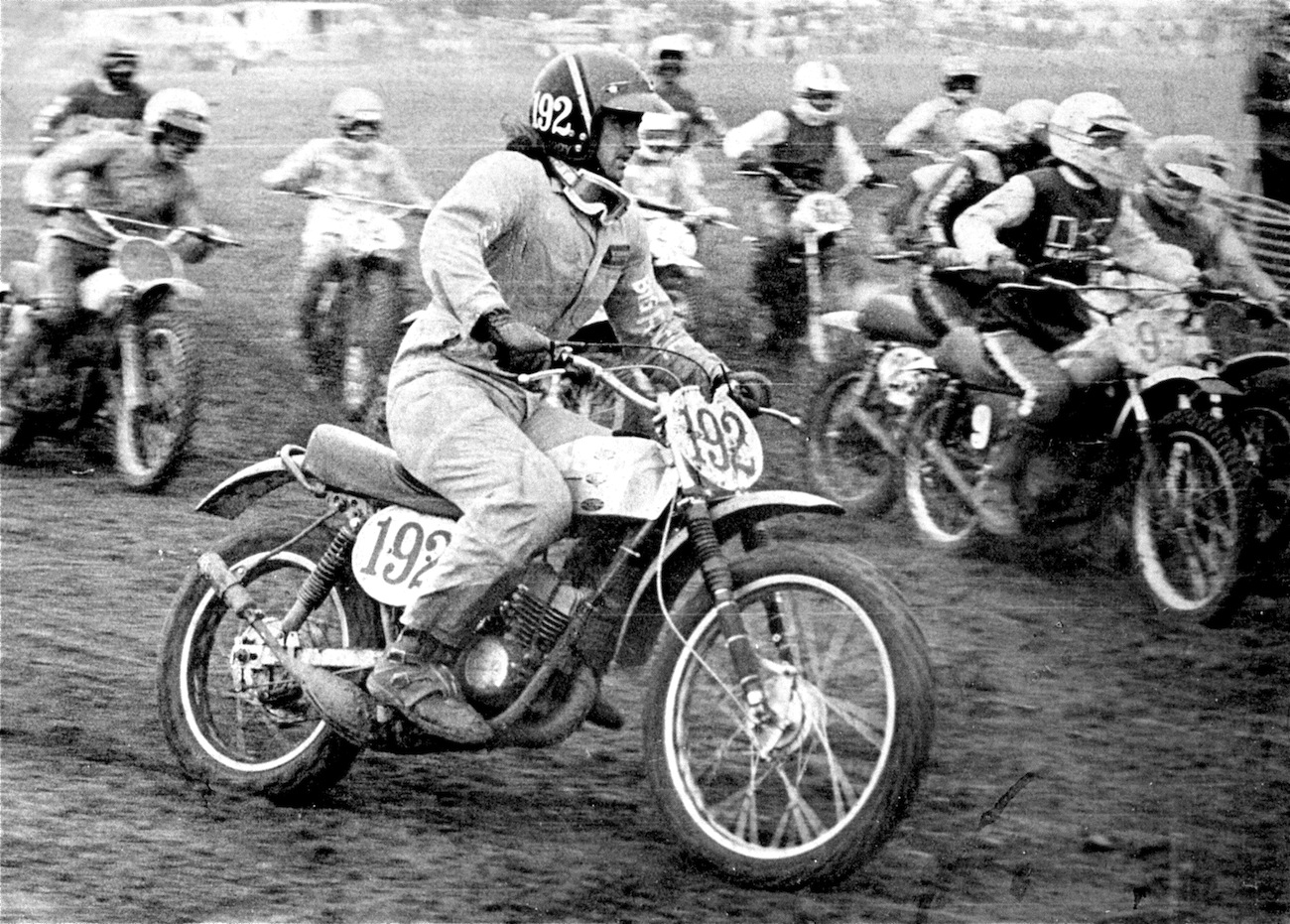 “To my way of thinking, by 1973 I had reached the “Peter Principle” (in that I had risen as high as I could with what speed I had, and to spend more time chasing it would only reveal my incompetence).
“To my way of thinking, by 1973 I had reached the “Peter Principle” (in that I had risen as high as I could with what speed I had, and to spend more time chasing it would only reveal my incompetence).
I was never the fastest guy at my local tracks, but I managed to win occasionally and make a name for myself in the late ’60s and early ’70s. Never deluded about my racing prowess (except for its 49-year duration), my window of opportunity was largely a result of being in on the ground floor. In short, I got here because I got there first.
Unlike a lot of my competitors, I was realistic about my chances of making a living as a Pro racer (in truth, making a living racing motocross wasn’t a viable career choice in 1968). To my way of thinking, by 1973 I had reached the “Peter Principle” (in that I had risen as high as I could with what speed I had, and to spend more time chasing it would only reveal my incompetence). That is a major epiphany for any athlete. It is your inner voice telling you, “You ain’t got it kid!” But what to do about it? No words of wisdom from my inner voice were forthcoming. Every athlete, in every sport, must answer this question at some point.
Luckily, I wasn’t hurting for options. I had gone to college throughout my racing career and would eventually work my way through the Bachelors, Masters and Doctor of Philosophy regimes. I was destined to become a college professor, but fate intervened. Just like today, magazines and cycle papers needed someone to ride the bikes for their test photos. Marvin Foster, an exec at Hodaka Motorcycles in Athena, Oregon, suggested me to Cycle News as an experienced motocross racer who was a good test rider. Cycle News‘ Richard Creed, one of the world’s greatest motocross photographers, called me and asked if I would test bikes for them.
It was a lark. It gave me a chance to thrash someone else’s bikes for a change. But, I didn’t like what the Cycle News editors wrote about the bikes that I rode for them. They never rode them themselves, they just asked me questions. I gave them what I thought were insightful answers, and they wrote fairy tales that had nothing to do with what I said. It was frustrating.
I HAD FOUND THE GOLDEN FLEECE; I WAS RACING, BUT GETTING PAID WHETHER I WON OR LOST. IT WAS THE DREAM JOB.
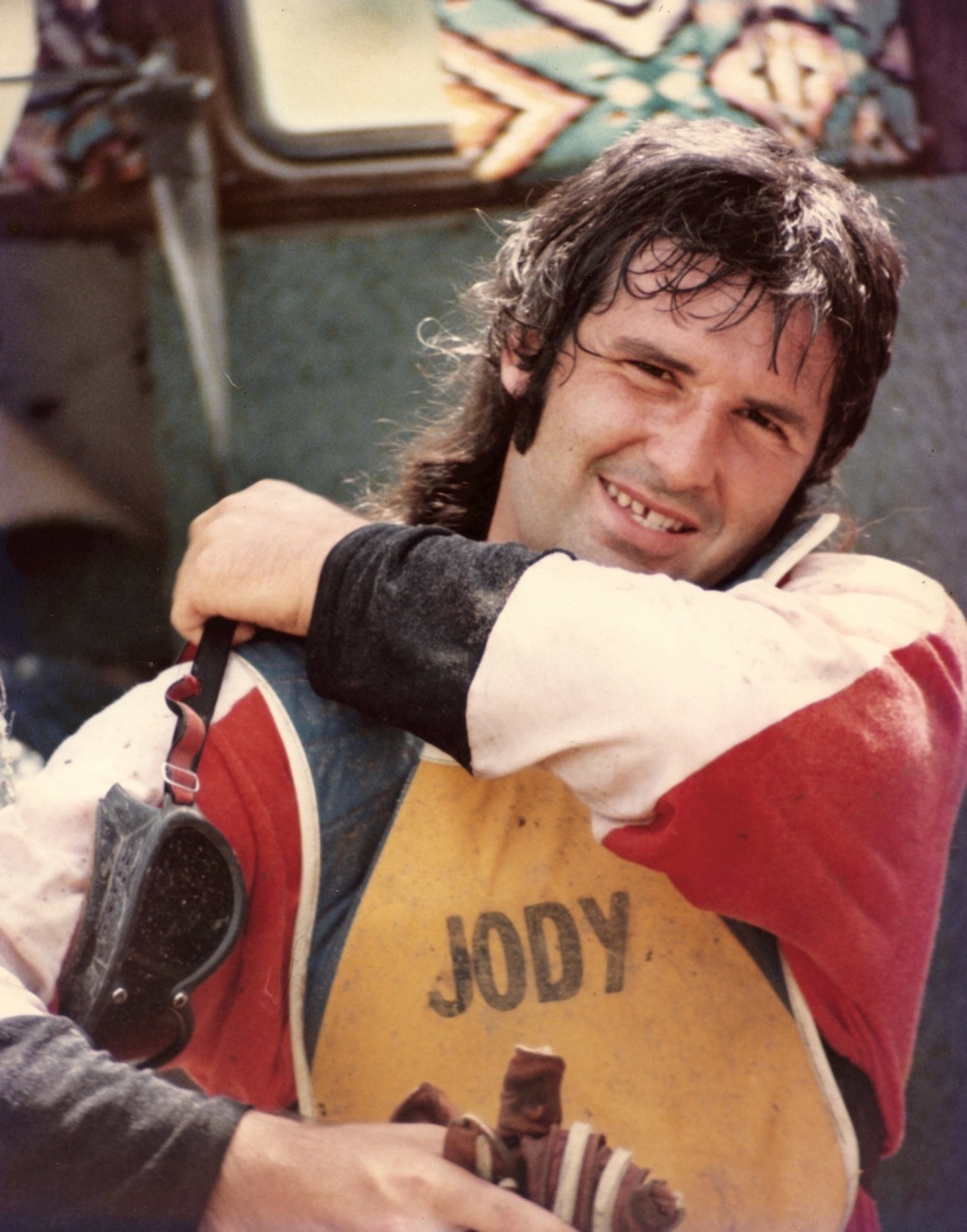 You have to go way back to have raced in rubber tank commander goggles—never mind the sideburns and Hallman GP chest protector.
You have to go way back to have raced in rubber tank commander goggles—never mind the sideburns and Hallman GP chest protector.
The solution came to me during a tedious college lecture on gerontology. Why not just write the test reports myself and cut out the middleman? After all, they were watering everything I told them down anyway. Surprisingly, Richard Creed thought it was a great idea. I suppose in retrospect it was a sweet deal for them, since I was doing their job for free.
But free was not the case for long. This was the formative age of Japanese motorcycles, and the Japanese are nothing if not thorough. They wanted to know everything there was to know about American motocrossers, and there were plenty of test riding opportunities. I had found the Golden Fleece; I was racing, but getting paid whether I won or lost (and I could justify losing by the fact that I was riding a bike that I wasn’t familiar with). It was the dream job. Subsequent to that, I never rode the same bike for longer than one month. More often than not, I raced a different bike in every moto. I tested parts for lots of companies — shocks, tires, reed valves, carbs and anything that could be bolted on a bike.
In 1975, Cycle News editor Richard Creed called and said that they needed people who actually raced motocross on their staff. I agreed to join them, but only if they let me do the complete Trans-AMA Series before reporting to work. They said okay and picked up the tab for the greatest ten weeks in my young life. I didn’t stay at Cycle News for very long, but I had fun. Within my first year, I had offers to work as a test editor at Cycle, Cycle World, Cycle Guide, Popular Cycling, Dirt Bike and a very small magazine called Motocross Action.
No suspense. I chose Motocross Action because it was about what I did. No fluff. No headlights. No speedometers. No posers (at least back in the day). It was all about motocross and only about motocross. I was no spring chicken at this point. I had started racing in 1968 on a Sachs, spent several years campaigning Hodakas and CZs, did two years of test rider gigs, worked at Cycle News from 1975 to 1976, and went to work at MXA on January 3, 1977. I’ll do the math for you — I’ve been at MXA for 40 years. It’s a record of some kind for something that nobody keeps records of.
I USED TO TEST A CZ, BULTACO OR CARABELA BY RIDING IT AS FAST AS I COULD. EVENTUALLY, I CRASHED OR IT BROKE. NO BIG DEAL.
 In his young days Jody had a single-minded approach to test riding—like on this Ossa Phantom II. This not how you test motocross bikes, this is how you test knee ligaments.
In his young days Jody had a single-minded approach to test riding—like on this Ossa Phantom II. This not how you test motocross bikes, this is how you test knee ligaments.
To this day, I still race every weekend. And just like 42 some odd years ago, I never race the same bike for longer than one month. And more often than not, I race a different bike in every moto. In the last four decades I have ridden virtually every motocross bike made, including most of the worthwhile works bikes, more roaches than a case of Raid could kill and some bikes that never got made. The list is impressive (not in small part because it dates back to the early 1970s).
In the 1970s, production bikes didn’t have very many tuning possibilities. There were no clickers on the shocks or forks, and you just rode them as they came out of the crate. I used to test a CZ, Bultaco, Maico, BSA, Ossa, Montesa or Carabela by riding it as fast as I could. If that didn’t tell me anything, I rode it faster. Eventually, I rode it so hard that I crashed or it broke. No big deal; breaking and crashing were an everyday part of life with the agricultural machinery of the 1970s.
 “I might have kept on with my flat-out approach to testing except for a run-in with Jeff Smith,” said Jody, seen here pitching a Montesa into a Saddleback corner until the footpeg drags and lifts the rear wheel off the ground.
“I might have kept on with my flat-out approach to testing except for a run-in with Jeff Smith,” said Jody, seen here pitching a Montesa into a Saddleback corner until the footpeg drags and lifts the rear wheel off the ground.
I might have kept on with my flat-out approach to testing except for a run-in with Jeff Smith. I raced the two-time 500 World Champion at Saddleback in the Vet Pro class, and when I passed him on the first lap I felt like I had reached the pinnacle of my racing life. It didn’t last long. A lap later, the BSA factory rider, 13 years my elder, wound it up and went by me at twice my speed. He disappeared from my view in short order. After the race, Jeff sat me down and said, “Jody, don’t try to go so fast. Take your time and build your speed. You have to slow down to go really fast.”
I absorbed Jeff’s comments and realized that what counts in a test rider is the ability to have a deft touch, to feel the bike and to eliminate himself from the equation. As a strict science, the only way to test motorcycles is as blindly as possible and with as much paperwork as humanly feasible. Shrugs, grunts and “it’s okay” comments are not acceptable. Engineers (and those writing consumer tests) need hard facts, spiced with words that have meaning. It’s not just the quality of the test rider that builds better motorcycles, or gives buyers a fighting chance at selecting the best one, but the rigorous examination that the test rider undergoes after spending time on a new bike. Flat-out speed in a test rider only makes him valuable as a race team test rider, where he is working on settings for the select and chosen few. The average rider isn’t fast and if forced to race Stewart’s, Dungey’s or Barcia’s bike would realize that what these men do and the machines they do it on have nothing in common with the rest of us. The worse test rider for a production motorcycle is a fast AMA Pro who still thinks he’s fast. A test rider has to think about not just the performance of the machine, but the end user as well.
“I DON’T CARE IF YOU’RE RIGHT OR WRONG, AS LONG AS YOU ARE ALWAYS RIGHT OR ALWAYS WRONG. BUT YOU CAN’T BE A GOOD TEST RIDER IF YOU ARE ONLY RIGHT HALF THE TIME.” ED SCHEIDLER.
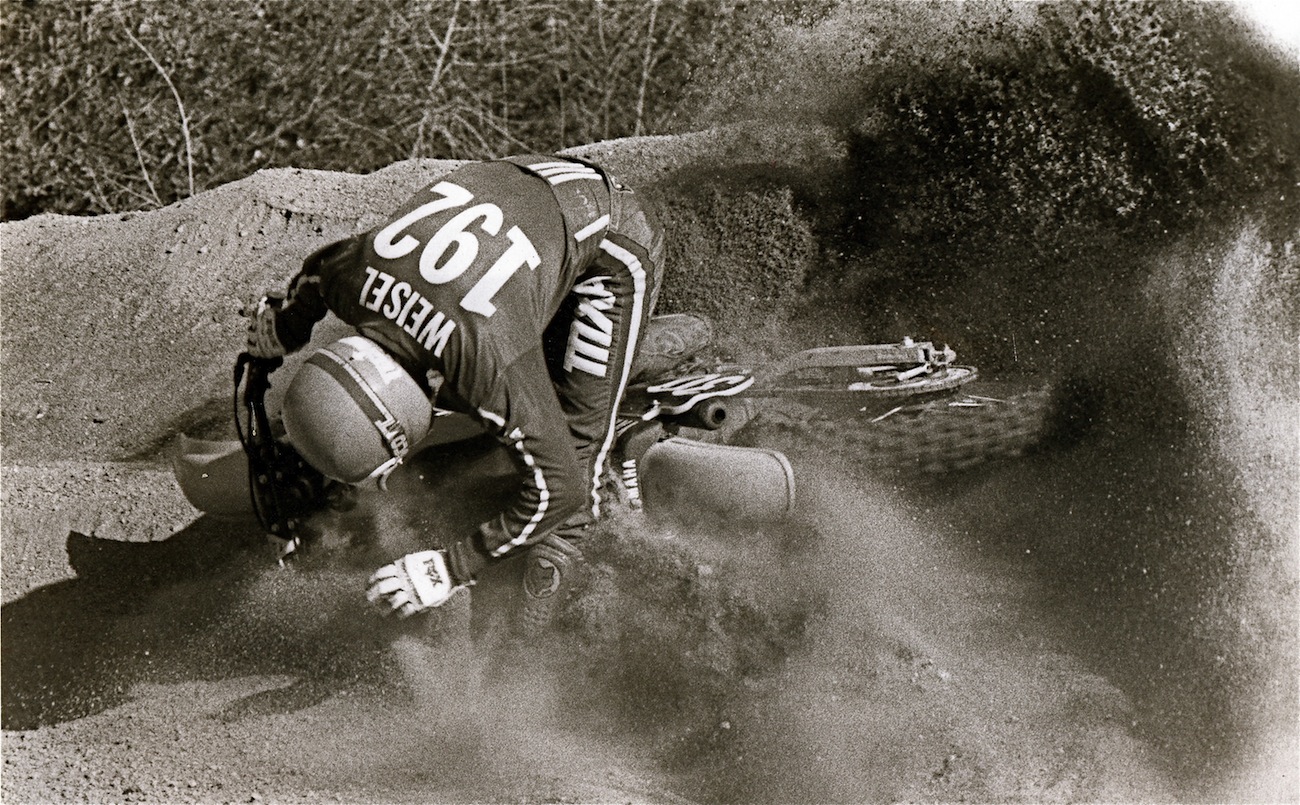 Crashing is a part of test riding. Every MXA test rider has been hurt at some point in his career. One word of advice; if you are going to crash like this, you might want to wear a chest protector and ditch the French-made Techno helmet.
Crashing is a part of test riding. Every MXA test rider has been hurt at some point in his career. One word of advice; if you are going to crash like this, you might want to wear a chest protector and ditch the French-made Techno helmet.
I’m not the world’s greatest test rider, but I can tell you the names of all the bad test riders on three sheets of paper (single-spaced and double-sided), while the names of the good ones would fit on a postage stamp. I pride myself on being consistent. I know what makes a good motorcycle, and I can identify those traits every time I ride a bike (I’ve had over 42 years of practice to get it right). Consistency is very important — but that consistency can only be proven via experience.
One day, when I was testing YZs with Yamaha’s most famous test engineer, Ed Scheidler, he told me something profound about being a test rider. “I don’t care if you’re right or wrong, as long as you are always right or always wrong. But you can’t be a good test rider if you are only right half the time.”
Ed and I didn’t always see eye-to-eye on testing. He would often send me out to test a part, only to find me back in the pits 15 seconds later, claiming that the mod was no good.
“How do you know if it was better or worse? You didn’t even do a full lap?” he’d bellow.
“I don’t need a full lap when it’s so far off,” I’d say. “In fact, I wanted to turn around on my way through the pits, but I gave you one corner out of courtesy.”
“Just put your seat in the saddle and do what I tell you,” he’d reply.
“DYNOS CONFIRM WHEN THE ENGINE BUILDER IS ON THE RIGHT TRACK, EXCEPT FOR WHEN HE IS ON THE WRONG TRACK.” MITCH PAYTON
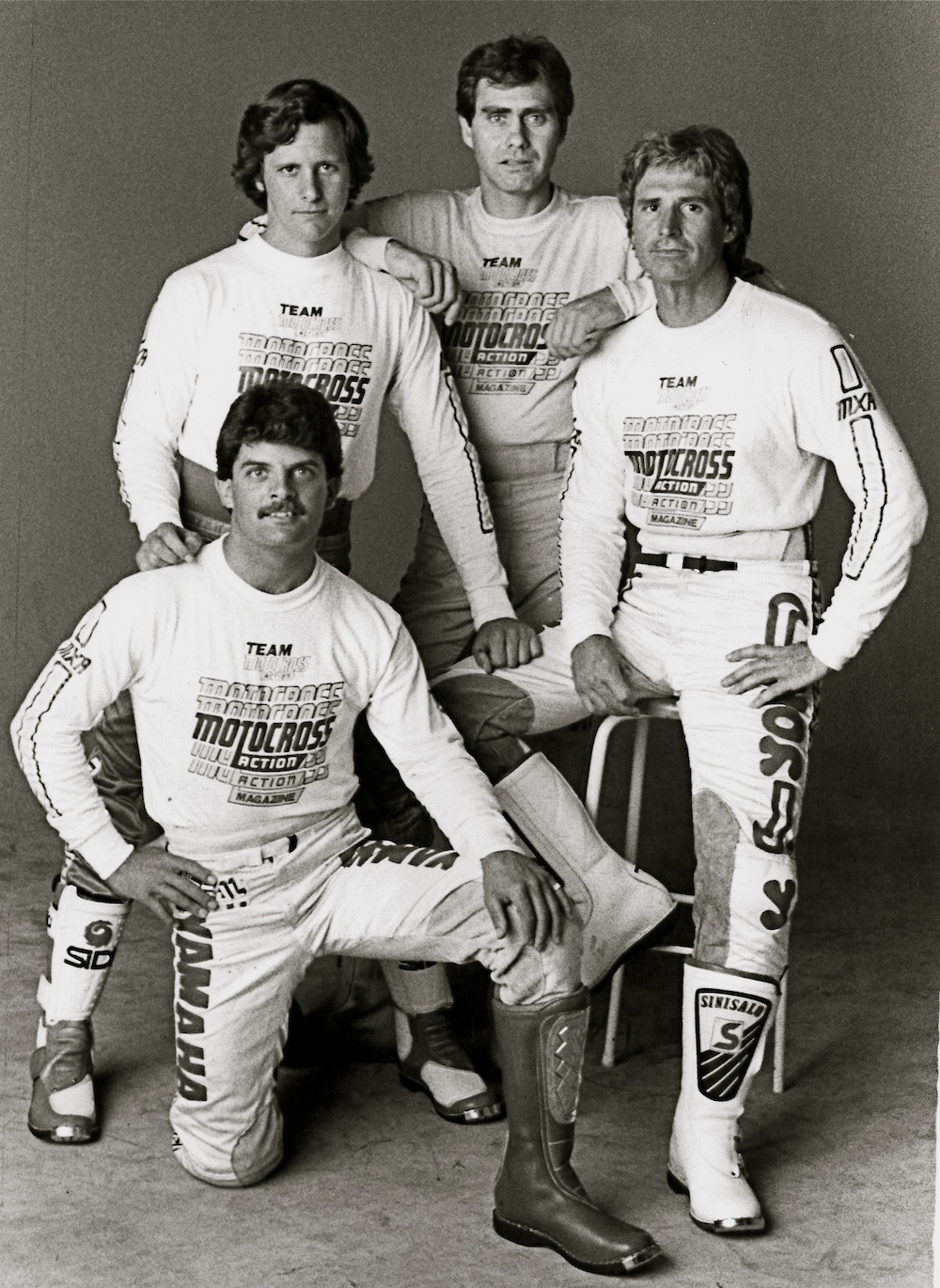 The MXA wrecking crew circa 1985. (Front row) Lance Moorewood. (Back row) David Gerig, Gary Jones and Jody Weisel.
The MXA wrecking crew circa 1985. (Front row) Lance Moorewood. (Back row) David Gerig, Gary Jones and Jody Weisel.
In 2006 I was testing the Husqvarna TC450. There was a lot of buzz about the bike, and Mitch Payton, an old-school Husqvarna fan, wanted to know what it was like to ride. I told him that it was like racing a “Lionel Electric Train.” Yet, on the dyno, the TC450 pumped out more horsepower than any other 450cc motocross bike in 2006. I asked Mitch how the Husqvarna could make so much power on the dyno and so little on the track, and he said, “Dynos confirm when the engine builder is on the right track, except for when he is on the wrong track.”
There are two kinds of dynos that I believe in: the human dyno and the dirt dyno.
The human dyno is Ed Scheidler’s seat in the saddle example. If you ride enough different bikes, and you have ridden the model that came before the one you’re testing (and the one that came before it, ad infinitum), you eventually hone your senses to feel fast from slow (or more accurately faster from slower). But this is pseudo science. As much as I trust senses that have done nothing but accelerate and decelerate for over 40 years, I know that they can be fooled, much like your depth perception in Knott’s Berry Farm’s tilted house. Cross referencing, by going back and forth between bikes, is a must.
Conversely, the dirt dyno has been my mainstay for all these decades. Unlike most test riders, I prefer to test by racing. Why? Because only in a race will I push to the limits of my now meager speed. Only at a race will I hit bumps that could be avoided on a practice day. Only at a race will I ask more of myself and thus more of the machine than I would on a Thursday. For most of the ’70s and ’80s, I tested at the famous Saddleback Park. I rode there thousands of times and, because of that, I could accurately predict my lap times without a stop watch. I knew to the millisecond if the bike I was testing was laying down tracks or just laying down and dying. Saddleback was my dirt dyno until it closed in 1984, Today, I race and test at Glen Helen, while my fellow MXA test riders follow the SoCal circuit of ten different tracks. They are young and eager—I’m old and wise.
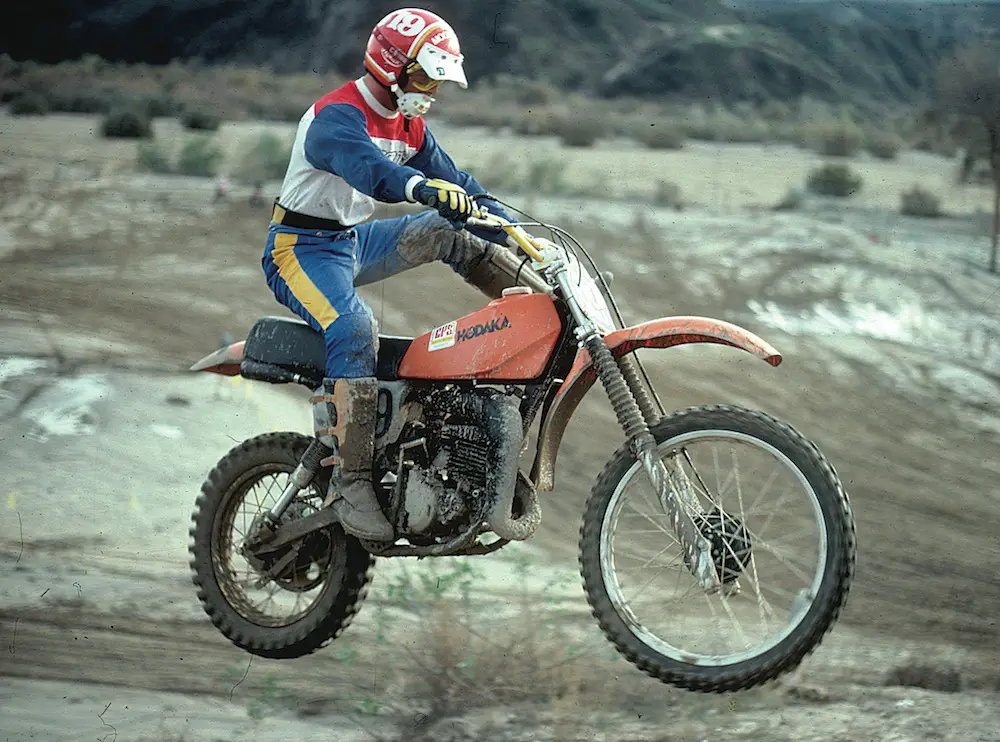 Another prototype that never got made. This was the Hodaka 250 Thunderdog motocross bike—based on the Thunderdog enduro model. Jody finished the project and shipped it back to Athena, Oregon, just in time for Hodaka to go out of business. The bike disappeared into the ether.
Another prototype that never got made. This was the Hodaka 250 Thunderdog motocross bike—based on the Thunderdog enduro model. Jody finished the project and shipped it back to Athena, Oregon, just in time for Hodaka to go out of business. The bike disappeared into the ether.
I’m older now than I was when Hodaka exec Marv Foster recommended me as a test rider so many decades ago. I like to think that I’m wiser, although I must admit that most of the know-how in my vast reservoir of worthless knowledge was achieved through osmosis. When I first started racing, I reveled in my ignorance. Not knowing what was going on was bliss, because there was nothing I could do about it anyway. My MX IQ increased as a direct result of the sheer number of bikes I rode, tech briefings I attended and smart people I associated with.
As a matter of political correctness, I’d love to claim that the years spent working on my Bachelors, Masters and PhD. were the keys to my success, and that every aspiring motorcycle test rider would do well to hit the books, stay in school and get a degree (or three). Perhaps in the world of Air Force test pilots, an engineering degree is a must, but for a motorcycle test rider, nothing beats an educated derriere — Ed Scheidler’s “seat in the saddle.”
The measure of a test rider isn’t defined by the coolness factor of being the first to ride a new bike, nor the fact that so few people are chosen to do the job. In function, test riders are worker ants who do their jobs virtually alone, on empty tracks with no one around to admire their handiwork. It is a job, not an adventure. When a test rider does his job right, either in the employ of a manufacturer or as the ombudsman of the consumer, he is an anonymous public servant. If he is honest, he serves the public by telling people something that they can’t find out for themselves — except at great cost. Truth is a rare commodity…which makes it worth seeking.
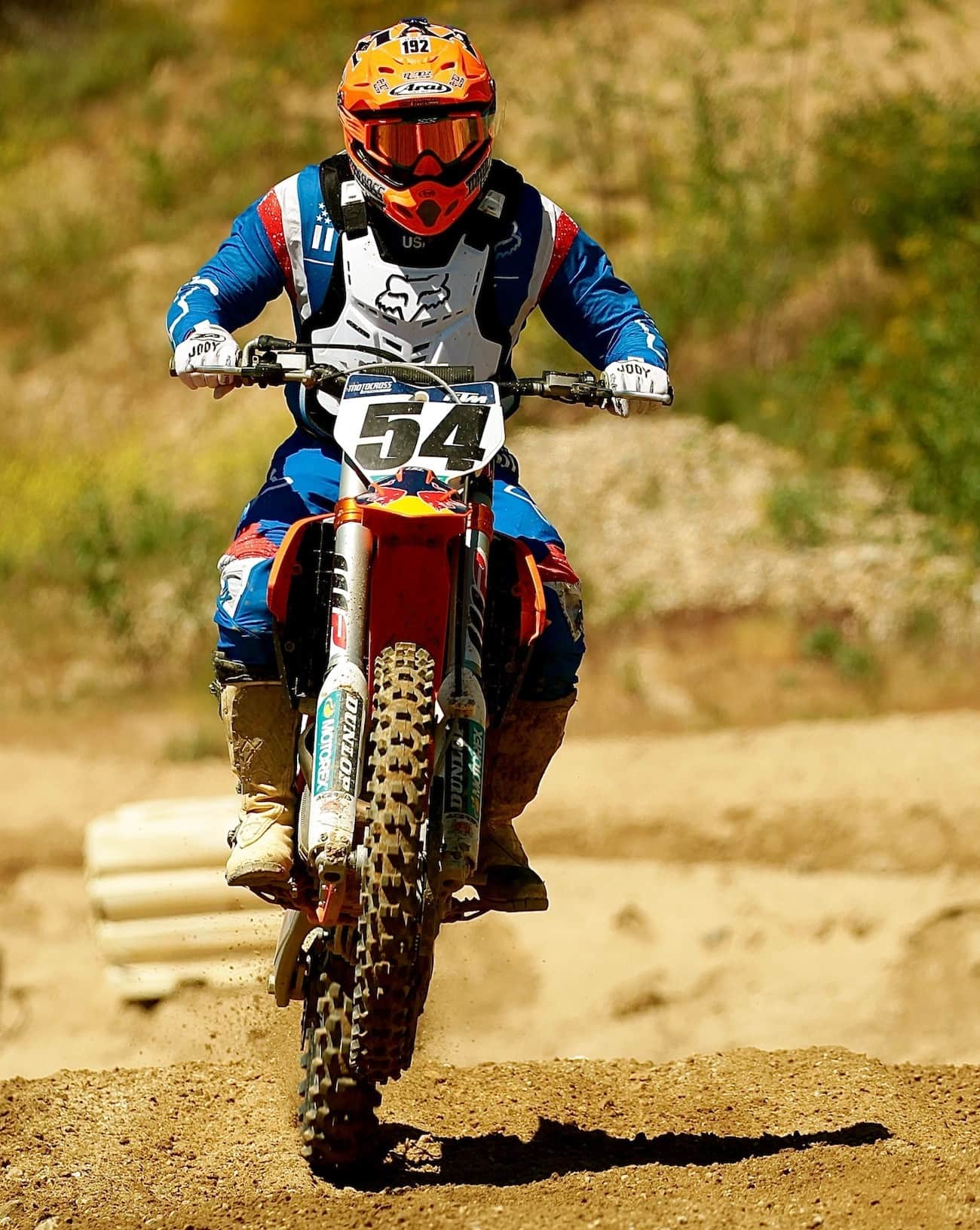 Jody, last weekend at Glen Helen on a 2017 KTM 450SXF Factory Edition, almost 50 years after his first race.
Jody, last weekend at Glen Helen on a 2017 KTM 450SXF Factory Edition, almost 50 years after his first race.
I like to think that every man who races a motorcycle is a test rider. Yes, you! You have it in your power to make your motorcycle better or worse — all you have to do is put your seat in the saddle and make some adjustments (and if you start today, you’ll have been testing motocross bikes for as long as I have when the year 2059 rolls around). Mark that date on your calendar.





Comments are closed.